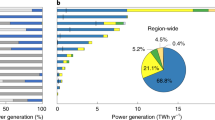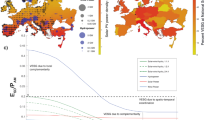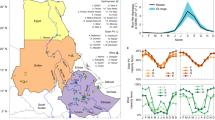Abstract
Hydropower will play an essential role in meeting the growing energy needs in Africa but will be affected by climate change. We assess future annual usable capacity and variability of supply for 87 existing hydropower plants in Africa on the basis of a multimodel ensemble of 21 global climate models and two emissions scenarios (representative concentration pathways RCP 4.5 and 8.5). We estimate near-future, mid-century and end-of-the-century impacts and assess the potential for connections within and across power pools to reduce changes in usable capacity and variability. We evaluate the potential synergies between hydropower, wind and solar resources in each power pool. We find that regional interconnection could mitigate some of the climate impacts on hydropower. Furthermore, variable renewable energy, especially solar power, could potentially compensate for usable hydropower capacity losses. Our work contributes to a better understanding of the climate-induced impacts on hydropower resources in Africa and potential risk mitigation opportunities.
This is a preview of subscription content, access via your institution
Access options
Access Nature and 54 other Nature Portfolio journals
Get Nature+, our best-value online-access subscription
$29.99 / 30 days
cancel any time
Subscribe to this journal
Receive 12 print issues and online access
$209.00 per year
only $17.42 per issue
Buy this article
- Purchase on Springer Link
- Instant access to full article PDF
Prices may be subject to local taxes which are calculated during checkout



Similar content being viewed by others
Data availability
We use open-access datasets to perform all calculations and analyses. Supplementary Table 13 summarizes the datasets collected for their application in the streamflow and hydropower formulations. We present the locations and characteristics of the power plants in Supplementary Table 1. We provide the individual time series in our online repository78. Finally, we present the complete list of GCMs used in Supplementary Table 14. The datasets generated and analysed during the current study are available in the zenodo repository (https://doi.org/10.5281/zenodo.5020878)80.
Code availability
R and Python codes used in the current study are available from the corresponding author on reasonable request.
References
Energy Projections for African Countries (Publications Office of the European Union, 2019); https://doi.org/10.2760/678700
Report Extract: Access to Electricity (International Energy Agency, 2020); https://www.iea.org/reports/sdg7-data-and-projections/access-to-electricity
Sustainable Development Goals (United Nations, 2015); https://sdgs.un.org/goals
Africa Clean Energy Corridor: Analysis of Infrastructure for Renewable Power in Eastern and Southern Africa (International Renewable Energy Agency, 2015).
2020 Hydropower Status Report: Sector Trends and Insights (International Hydropower Association, 2020); https://www.hydropower.org/publications/2020-hydropower-status-report
2021 Hydropower Status Report: Sector Trends and Insights (International Hydropower Association, 2021); https://assets-global.website-files.com/5f749e4b9399c80b5e421384/60c37321987070812596e26a_IHA20212405-status-report-02_LR.pdf
Africa Energy Outlook 2019 (International Energy Agency, 2019); https://iea.blob.core.windows.net/assets/2f7b6170-d616-4dd7-a7ca-a65a3a332fc1/Africa_Energy_Outlook_2019.pdf
The PIDA Energy Vision (African Development Bank Group, 2016); https://www.afdb.org/fileadmin/uploads/afdb/Documents/Generic-Documents/PIDA%20brief%20Energy.pdf
Cervigni, R., Liden, R., Neumann, J. E. & Strzepek, K. M. Enhancing the Climate Resilience of Africa’s Infrastructure: The Power and Water Sectors (Africa Development Forum, 2015); https://doi.org/10.1596/978-1-4648-0466-3
Falchetta, G., Gernaat, D. E. H. J., Hunt, J. & Sterl, S. Hydropower dependency and climate change in sub-Saharan Africa: a nexus framework and evidence-based review. J. Clean. Prod. 231, 1399–1417 (2019).
Climate Impacts on African Hydropower (International Energy Agency, 2020); https://www.iea.org/reports/climate-impacts-on-african-hydropower
van Vliet, M. T. H., Wiberg, D., Leduc, S. & Riahi, K. Power-generation system vulnerability and adaptation to changes in climate and water resources. Nat. Clim. Change 6, 375–380 (2016).
Yalew, S. G. et al. Impacts of climate change on energy systems in global and regional scenarios. Nat. Energy 5, 794–802 (2020).https://doi.org/10.1038/s41560-020-0664-z
Turner, S. W. D., Ng, J. Y. & Galelli, S. Examining global electricity supply vulnerability to climate change using a high-fidelity hydropower dam model. Sci. Total Environ. 590–591, 663–675 (2017).
van Vliet, M. T. H. et al. Multi-model assessment of global hydropower and cooling water discharge potential under climate change. Glob. Environ. Change 40, 156–170 (2016).
Turner, S. W. D., Hejazi, M., Kim, S. H., Clarke, L. & Edmonds, J. Climate impacts on hydropower and consequences for global electricity supply investment needs. Energy 141, 2081–2090 (2017).
Kling, H., Stanzel, P. & Preishuber, M. Impact modelling of water resources development and climate scenarios on Zambezi River discharge. J. Hydrol. Reg. Stud. 1, 17–43 (2014).
Stanzel, P., Kling, H. & Bauer, H. Climate change impact on West African rivers under an ensemble of CORDEX climate projections. Clim. Serv. 11, 36–48 (2018).
Conway, D., Dalin, C., Landman, W. A. & Osborn, T. J. Hydropower plans in Eastern and Southern Africa increase risk of concurrent climate-related electricity supply disruption. Nat. Energy 2, 946–953 (2017).
Spalding-Fecher, R., Joyce, B. & Winkler, H. Climate change and hydropower in the Southern African power pool and Zambezi River Basin: system-wide impacts and policy implications. Energy Policy 103, 84–97 (2017).
Sidibe, M. et al. Near-term impacts of climate variability and change on hydrological systems in West and Central Africa. Clim. Dynam. 54, 2041–2070 (2020).
Kling, H., Stanzel, P. & Fuchs, M. Regional assessment of the hydropower potential of rivers in West Africa. Energy Procedia 97, 286–293 (2016).
Cole, M. A., Elliott, R. J. R. & Strobl, E. Climate change, hydro-dependency, and the African dam boom. World Dev. 60, 84–98 (2014).
van Vliet, M. T. H., Sheffield, J., Wiberg, D. & Wood, E. F. Impacts of recent drought and warm years on water resources and electricity supply worldwide. Environ. Res. Lett. 11, 124021 (2016).
Busch, S., de Felice, M. & Hidalgo Gonzalez, I. Analysis of the Water–Power Nexus in the Southern African Power Pool (Publications Office of the European Union, 2020); https://doi.org/10.2760/920794
Scaling Up Renewable Energy Deployment in Africa: Detailed Overview of IRENA’s Engagement and Impact (International Renewable Energy Agency, 2020); https://www.irena.org/-/media/Files/IRENA/Agency/Publication/2020/Feb/IRENA_Africa_Impact_Report_2020.pdf
Renewable Energy Market Analysis: Africa and its Regions (IRENA and AfDB, 2022); https://www.irena.org/-/media/Files/IRENA/Agency/Publication/2022/Jan/IRENA_Market_Africa_2022.pdf
Sridharan, V. et al. Resilience of the Eastern African electricity sector to climate driven changes in hydropower generation. Nat. Commun. 10, 302 (2019).
Sterl, S., Fadly, D., Liersch, S., Koch, H. & Thiery, W. Linking solar and wind power in eastern Africa with operation of the Grand Ethiopian Renaissance Dam. Nat. Energy 6, 407–418 (2021).https://doi.org/10.1038/s41560-021-00799-5
Sterl, S., Liersch, S., Koch, H., Lipzig, N. P. Mvan & Thiery, W. A new approach for assessing synergies of solar and wind power: implications for West Africa. Environ. Res. Lett. 13, 094009 (2018).
Pavičević, M. & Quoilin, S. Analysis of the Water–Power Nexus in the North, Eastern and Central African Power Pools (Publications Office of the European Union, 2020); https://doi.org/10.2760/12651
de Felice, M., Gonzalez Aparicio, I., Huld, T., Busch, S. & Hidalgo Gonzalez, I. Analysis of the Water–Power Nexus in the West African Power Pool (Publications Office of the European Union, 2019); https://doi.org/10.2760/362802
Wu, G. C. et al. Strategic siting and regional grid interconnections key to low-carbon futures in African countries. Proc. Natl Acad. Sci. USA 114, E3004–E3012 (2017).
Wu, G. C., Deshmukh, R., Ndhlukula, K., Radojicic, T. & Reilly, J. Renewable Energy Zones for the Africa Clean Energy Corridor (IRENA, 2015); https://www.irena.org/-/media/Files/IRENA/Agency/Publication/2015/IRENA-LBNL_Africa-RE-_CEC_2015.pdf
Sterl, S. et al. Smart renewable electricity portfolios in West Africa. Nat. Sustain. 3, 710–719 (2020).
Gernaat, D. E. H. J. et al. Climate change impacts on renewable energy supply. Nat. Clim. Change 11, 119–125 (2021).
Hofste, R. W. et al. Aqueduct 3.0: Updated Decision-Relevant Global Water Risk Indicators (World Resources Institute, 2019); https://www.wri.org/publication/aqueduct-30
Renewable Capacity Statistics 2021 (International Renewable Energy Agency, 2021); https://www.irena.org/-/media/Files/IRENA/Agency/Publication/2021/Apr/IRENA_RE_Capacity_Statistics_2021.pdf
Tong, D. et al. Geophysical constraints on the reliability of solar and wind power worldwide. Nat. Commun. 12, 6146 (2021).
Sawadogo, W. et al. Current and future potential of solar and wind energy over Africa using the RegCM4 CORDEX-CORE ensemble. Clim. Dynam. 57, 1647–1672 (2021).
Bichet, A. et al. Potential impact of climate change on solar resource in Africa for photovoltaic energy: analyses from CORDEX-AFRICA climate experiments. Environ. Res. Lett. 14, 124039 (2019).
The Renewable Energy Transition in Africa: Powering Access, Resilience and Prosperity (International Renewable Energy Agency, 2021); https://www.irena.org/-/media/Files/IRENA/Agency/Publication/2021/March/Renewable_Energy_Transition_Africa_2021.pdf
Statistical Review of World Energy (BP, 2021); https://www.bp.com/en/global/corporate/energy-economics/statistical-review-of-world-energy.html
Share of Electricity Production from Hydropower (Our World in Data, 2021); https://ourworldindata.org/grapher/share-electricity-hydro?tab=chart&stackMode=absolute&time=earliest..latest®ion=Africa
African Union Development Agency. General Procurement Notice—Multinational—Continental Power System Master Plan Project (African Development Bank Group, 2022); https://www.afdb.org/en/documents/gpn-multinational-continental-power-system-master-plan-project-cmp
Region Profile: Africa (2020 Data) (International Hydropower Association, 2020); https://www.hydropower.org/region-profiles/africa
de Faria, F. A. M., Jaramillo, P., Sawakuchi, H. O., Richey, J. E. & Barros, N. Estimating greenhouse gas emissions from future Amazonian hydroelectric reservoirs. Environ. Res. Lett. 10, 124019 (2015).
Jurasz, J., Canales, F. A., Kies, A., Guezgouz, M. & Beluco, A. A review on the complementarity of renewable energy sources: concept, metrics, application and future research directions. Sol. Energy 195, 703–724 (2020).
Deemer, B. R. et al. Greenhouse gas emissions from reservoir water surfaces: a new global synthesis. BioScience 66, 949–964 (2016).
Barros, N. et al. Carbon emission from hydroelectric reservoirs linked to reservoir age and latitude. Nat. Geosci. 4, 593–596 (2011).
Boulange, J., Hanasaki, N., Yamazaki, D. & Pokhrel, Y. Role of dams in reducing global flood exposure under climate change. Nat. Commun. 12, 417 (2021).
Gernaat, D. E. H. J., Bogaart, P. W., Vuuren, D. P., van, Biemans, H. & Niessink, R. High-resolution assessment of global technical and economic hydropower potential. Nat. Energy 2, 821–828 (2017).
Hydropower Special Market Report: Analysis and Forecast to 2030 (International Energy Agency, 2021); https://www.iea.org/reports/hydropower-special-market-report
Bishoge, O. K., Kombe, G. G. & Mvile, B. N. Renewable energy for sustainable development in sub-Saharan African countries: challenges and way forward. J. Renew. Sustain. Energy 12, 052702 (2020).
Electricity, Net Installed Capacity of Electric Power Plants (UNdata, 2021); http://data.un.org/Data.aspx?d=EDATA&f=cmID%3aEC%3btrID%3a133
Randolph Glacier Inventory—A Dataset of Global Glacier Outlines Version 6.0 (NSIDC, 2017); https://doi.org/10.7265/N5-RGI-60
Abatzoglou, J. T., Dobrowski, S. Z., Parks, S. A. & Hegewisch, K. C. TerraClimate, a high-resolution global dataset of monthly climate and climatic water balance from 1958-2015. Sci. Data 5, 170191 (2018).
Navarro-Racines, C., Tarapues, J., Thornton, P., Jarvis, A. & Ramirez-Villegas, J. 2020. High-resolution and bias-corrected CMIP5 projections for climate change impact assessments. Sci. Data 7, 7 (2020).
Caceres, A. L., Jaramillo, P., Matthews, H. S., Samaras, C. & Nijssen, B. Hydropower under climate uncertainty: characterizing the usable capacity of Brazilian, Colombian and Peruvian power plants under climate scenarios. Energy Sustain. Dev. 61, 217–229 (2021).
Bartos, M. D. Pysheds: a fast, open-source digital elevation model processing library (pythonlang.dev, 2018).
Lehner, B., Verdin, K. & Jarvis, A. New global hydrography derived from spaceborne elevation data. Eos 89, 93–94 (2008).
Jarvis, A., Reuter, H. I. I., Nelson, A. & Guevara, E. Hole-filled Seamless SRTM Data Version 4 (International Centre for Tropical Agriculture, 2008); http://srtm.csi.cgiar.org
Sanchez, P. A. et al. Digital soil map of the world. Science 325, 680–681 (2009).
Kanamitsu, W. et al. NCEP-DOE AMIP-II Reanalysis (R-2) (American Meteorological Society, 2020).
Ziese, M. et al. GPCC Full Data Daily Version 2018 at 1.0°: Daily Land–Surface Precipitation from Rain-Gauges built on GTS-based and Historic Data (Global Precipitation Climatology Centre, 2018); https://doi.org/10.5676/DWD_GPCC/FD_D_V2018_100
Bfg. Global Runoff Database. Accessed Oct. 20, 2021; https://wbwaterdata.org/dataset/global-runoff-data-centre-grdc
Ghiggi, G., Humphrey, V., Seneviratne, S. I. & Gudmundsson, L. GRUN: an observations-based global gridded runoff dataset from 1902 to 2014. Earth Syst. Sci. Data Discuss. https://doi.org/10.5194/essd-2019-32 (2019).
NEX-GDDP Dataset (Climate Analytics Group & NASA Ames Research Center, 2018).
van Vuuren, D. P., Edmonds, J. A., Kainuma, M., Riahi, K. & Weyant, J. A special issue on the RCPs. Clim. Change 109, 1 (2011).
Schwalm, C. R., Glendon, S. & Duffy, P. B. RCP8.5 tracks cumulative CO2 emissions. Proc. Natl Acad. Sci. USA 117, 19656–19657 (2020).
IPCC: Summary for Policymakers. In Climate Change 2013: The Physical Science Basis (eds Stocker, T. F. et al.) (Cambridge Univ. Press, 2013).
The CMIP6 landscape. Nat. Clim. Change 9, 727–727 (2019).
FAQ Data and Access (WCRP CORDEX, 2020); https://cordex.org/faq/faq-data-and-access/
Lehner, B. et al. Global Reservoir and Dam Database Version 1 (NASA Socioeconomic Data and Applications Center, 2011); http://www.gwsp.org/fileadmin/downloads/GRanD_Technical_Documentation_v1_1.pdf
Turner, S. W. D. & Galelli, S. Water supply sensitivity to climate change: an R package for implementing reservoir storage analysis in global and regional impact studies. Environ. Model. Softw. 76, 13–19 (2016).
Wu, X., Cheng, C., Lund, J. R., Niu, W. & Miao, S. Stochastic dynamic programming for hydropower reservoir operations with multiple local optima. J. Hydrol. 564, 712–722 (2018).
Feng, Z., Niu, W., Cheng, C. & Lund, J. R. Optimizing hydropower reservoirs operation via an orthogonal progressive optimality algorithm. J. Water Resour. Plan. Manag. 144, 04018001 (2018).
Marwick, B. & Krishnamoorthy, K. cvequality: Tests for the equality of coefficients of variation from multiple groups. R package v. 2.0 (2019).
Yan, J. et al. Reviews on characteristic of renewables: evaluating the variability and complementarity. Int. Trans. Electr. Energy Syst. 30, e12281 (2020).https://doi.org/10.1002/2050-7038.12281
Cáceres, A. L., Jaramillo, P., Matthews, H. S., Samaras, C. & Nijssen, B. Climate forced hydropower simulations for the African continent using NASA NEX GDDP. Zenodo https://doi.org/10.5281/zenodo.5020878 (2021).
Acknowledgements
This study was supported by the Rockefeller Foundation through a subcontract with the University of Massachusetts at Amherst (subaward no. 19-10766 A 00). This article was prepared while C.S. was affiliated with Carnegie Mellon University. The opinions expressed in this article are the authors’ own and do not reflect the view of the US government or any other organization.
Author information
Authors and Affiliations
Contributions
A.L.C., P.J., H.S.M., C.S. and B.N. conceived and designed the study. A.L.C. collected the data, developed the model, developed the results and led the manuscript preparation. All authors interpreted the results and contributed to the manuscript writing.
Corresponding author
Ethics declarations
Competing interests
C.S. declares a potentially perceived non-financial competing interest. After the completion of this paper, C.S. began a temporary mobility employment assignment with the US government through the Intergovernmental Personnel Act. C.S. is on Public Service Leave and this article was prepared while he was employed at Carnegie Mellon University. The remaining authors declare no competing interests.
Peer review
Peer review information
Nature Climate Change thanks Ranjit Deshmukh, Giacomo Falchetta and the other, anonymous, reviewer(s) for their contribution to the peer review of this work.
Additional information
Publisher’s note Springer Nature remains neutral with regard to jurisdictional claims in published maps and institutional affiliations.
Extended data
Extended Data Fig. 1 Aggregated usable capacity for the COMELEC, CAPP, EAPP, SAPP, and WAPP.
The boxplots present the results from the multimodel ensemble of 21 GCM experiments for the 1970–2005 historical reference (wheat), RCP 4.5 (orange), and RCP 8.5 (purple). Each column presents the time frame of the analysis: near-future (2010–2039), mid-century (2040–2069), and end-of-century (2070–2099). The scales of each of the panels are different depending on the power pool.
Extended Data Fig. 2 Probability Density Function of Aggregated Multi-Model Ensemble Power Pool Usable Capacity Time Series.
The Y axis of the plot represents the probability for a usable capacity (MW) value for the power pool. We include all five power pools in the analysis (COMELEC, WAPP, CAPP, EAPP, and SAPP). We present three scenarios (historical reference, RCP 4.5, and RCP 8.5) and three time frames (early century – 2010–2039, mid-century – 2040–2069, and end of the century – 2070–2099). We present the historical reference in “wheat” colour, RCP 4.5 in “orange” colour, and RCP 8.5 in “purple” colour.
Extended Data Fig. 3 Exceedance Probability of Aggregated Multi-Model Ensemble Power Pool Usable Capacity Time Series.
The Y axis of the plot represents the exceedance probability of usable capacity (MW) for the power pool. We include all five power pools in the analysis (COMELEC, WAPP, CAPP, EAPP, and SAPP). We present three scenarios (historical reference, RCP 4.5, and RCP 8.5) and three time frames (early century – 2010–2039, mid-century – 2040–2069, and end of the century – 2070–2099). We present the historical reference in “wheat” colour, RCP 4.5 in “orange” colour, and RCP 8.5 in “purple” colour.
Supplementary information
Supplementary Information
Supplementary Notes 1–3, Figs. 1–22, Tables 1–14 and references.
Rights and permissions
About this article
Cite this article
Cáceres, A.L., Jaramillo, P., Matthews, H.S. et al. Potential hydropower contribution to mitigate climate risk and build resilience in Africa. Nat. Clim. Chang. 12, 719–727 (2022). https://doi.org/10.1038/s41558-022-01413-6
Received:
Accepted:
Published:
Issue Date:
DOI: https://doi.org/10.1038/s41558-022-01413-6
This article is cited by
-
Avoiding ecosystem and social impacts of hydropower, wind, and solar in Southern Africa’s low-carbon electricity system
Nature Communications (2024)
-
Hydropower expansion in eco-sensitive river basins under global energy-economic change
Nature Sustainability (2024)
-
Sustainable pathways towards universal renewable electricity access in Africa
Nature Reviews Earth & Environment (2024)
-
A global-scale framework for hydropower development incorporating strict environmental constraints
Nature Water (2023)



